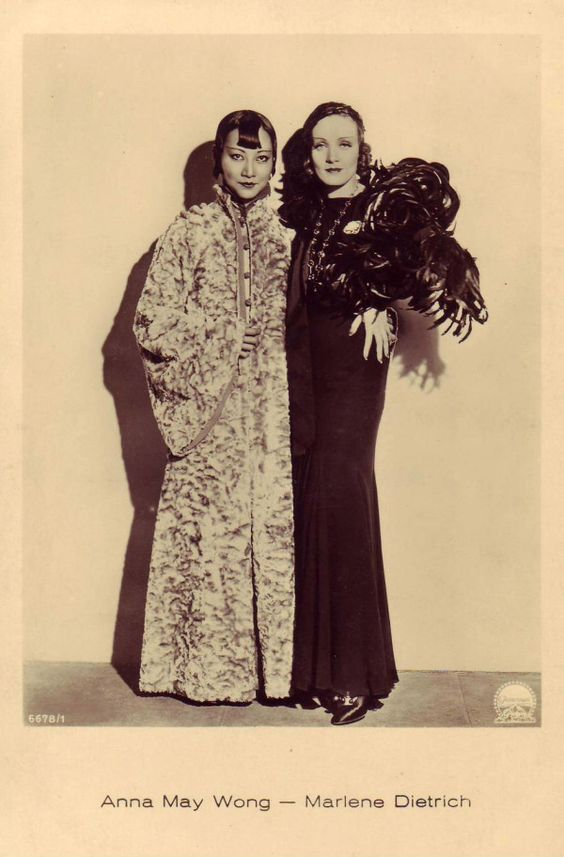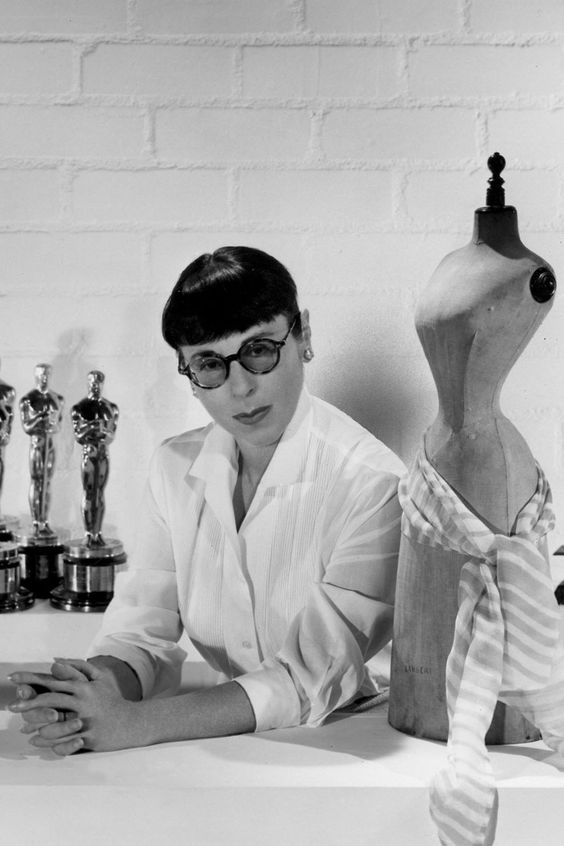In the golden era of Hollywood, where celluloid dreams came to life, costume designers played an integral role in crafting the iconic looks that defined the era both on and off-screen. 1930s & 40s Hollywood was a time of glamour, sophistication, and escapism, with visionaries whose needles and thread wove magic into the fabric of cinema. Let’s look at some of the most iconic designs of the time, and the influential designers behind them.
ADRIAN
Adrian Adolph Greenberg, known simply as Adrian, was one of the most celebrated costume designers of the 1930s and 40s. Born on the 3rd of March 1903, in Connecticut, Adrian’s passion for fashion and design blossomed at an early age. After studying at the New York School of Fine and Applied Arts, he began his career as a costume designer on Broadway.

Adrian in 1938 - portrait by George Hurrell
It wasn’t long before he caught the eye of film producers, and in 1928, he made the leap to the West Coast to join the costume department at MGM as chief designer. His usual onscreen credit was often “Gowns by Adrian” rather than his full name. Adrian designed costumes for over 200 films in his film career, and sadly never won an Academy Award for his designs as he was working at a time before the category was introduced (the Academy Award for Best Costume Design was created in 1949, seven years after Adrian left the film industry).
Adrian was a master of silhouette, using shape and form to enhance the personalities of the stars he dressed. Adrian’s designs for 'The Wizard of Oz’ (1939), where he created the most iconic shoes in film history for Dorothy’s ruby slippers, and ‘The Women’ (1939) showcased his impeccable taste and attention to detail. Throughout his film career, he collaborated with some of the biggest stars of the time including Greta Garbo, Joan Crawford, Judy Garland, and his wife Janet Gaynor.
One of the most influential contributions to fashion was the creation of the ‘Adrian Shoulder’. When designing for Joan Crawford, Adrian emphasised her shoulders by designing outfits with shoulder pads, creating a shoulder style that became synonymous with the era’s fashion, inspiring the wardrobes of cinema-goers who worshipped the glamour of the big screen (even some Seamstress of Bloomsbury styles feature shoulder pads thanks to Adrian's influence on the fashion world!). In 1942, Adrian left MGM to launch his successful fashion line in Beverley Hills.

'The Wizard of Oz' (1939), featuring Dorothy's iconic shoes worn by Judy Garland

Publicity photo for 'The Women' (1939) featuring Norma Shearer, Joan Crawford, and Rosalind Russell

'The Philadelphia Story' (1940) featuring Katharine Hepburn
EDITH HEAD
No discussion of Hollywood costume design would be complete without mentioning Edith Head. With an illustrious career spanning over five decades, Edith Head’s influence on the world of fashion and film is undeniable. Head is instantly recognisable thanks to her thick glasses and fringe, a look recreated in the animated film 'The Incredibles' (2005) for designer Edna Mode.
Edith Head
Edith was born on the 28th of October, 1897, in California. Originally, her career was teaching Spanish, but was much more interested in design. Deciding on a career change, Edith began studying at the University of California, and then the Chouinard Art Institute, she began working as a sketch artist at Paramount Pictures in 1924. She was quickly promoted to costume designer where she remained for 44 years.
Head was known for her unique working style and, unlike many of her male contemporaries, usually consulted extensively with the female stars with whom she worked.
From the iconic black dress worn by Audrey Hepburn in 'Breakfast at Tiffany’s' (1961) to the glamorous ensembles of Grace Kelly in 'To Catch a Thief' (1955), Head was another designer who worked with some of the biggest stars and directors of the era. When 1967 rolled around, Paramount declined to renew her contract, and she was invited by Alfred Hitchcock (whom she had worked with on many films) to join him at Universal Pictures. There she earned her eighth and final Academy Award for her work on 'The Sting' in 1973.
Head was nominated for an Academy Award for Best Costume Design a staggering 35 times and won a record-breaking 8 Academy Awards for Best Costume Design.

Grace Kelly and Cary Grant, 'To Catch a Thief' (1955)

Bette Davis in 'All About Eve' (1950)

Audrey Hepburn in Roman Holiday (1953)
ORRY-KELLY
Another luminary in the world of Hollywood costume design was Orry-Kelly. Born in Kiama, New South Wales, Australia, Orry-Kelly made a name for himself in Tinseltown with his exquisite creations. He worked closely with stars like Bette Davis and Marilyn Monroe.

Orry-Kelly
Orry-Kelly originally studied banking in Sydney, but he quickly developed an interest in theatre and the arts. Before long, Orry-Kelly was venturing to Broadway and then to Hollywood in the early 1930s. Warner Brothers snatched up a contract with Orry-Kelly first in 1932 where he remained as their chief costume designer until 1944, whilst ‘studio hopping’ to work with RKO, MGM, Universal, and 20th Century Fox.
He specialised in creating more straightforward and wearable looks, which would easily be recreated by the cinema-going audience. Orry-Kelly also designed for distraction, and would cunningly disguise yet flatter any less-than-perfect elements of the stars with statement pockets & buttons to distract the audience.
With a keen eye for detail, he brought to life some of the most iconic costumes ever to grace the silver screen and won him three Academy Awards. From the elegant gowns for Bette Davis in 'Now, Voyager' (1942), to the sultry ensembles of Marilyn Monroe in 'Some Like it Hot' (1959), Orry-Kelly’s designs captured the essence of the characters he dressed. Some of his best work is featured in 'Casablanca' (1942), where he created Ingrid Bergman’s flawless outfits.

Ingrid Bergman, 'Casablanca' (1942)

Bette Davis in 'Now, Voyager' (1942)

Dolores del Rio and Everett Marshal, 'I Live for Love' (1935)
TRAVIS BANTON
Known for his extravagant creations, Banton’s designs graced the silver screen in some of the most memorable films of the era. Born in Waco, Texas, in 1894, Banton studied at the Art Students League in New York, before making his way to Hollywood in the 1920s where he quickly rose to fame at Paramount Pictures. Throughout his career, he worked closely with director Josef von Sternberg and Marlene Dietrich - his designs for Marlene Dietrich are still referenced by designers today due to their boldness and sensuality.

Travis Banton and Marlene Dietrich, 1937
From the sleek sophistication of Marlene Dietrich’s wardrobe in 'Shanghai Express' (1932) to the opulent costumes of 'Cleopatra' (1934), Banton’s work epitomised the grandeur of the 1930s.

Anna May Wong and Marlene Dietrich, 'Shanghai Express' (1932)

Claudette Colbert, 'Cleopatra' (1934)

Rita Hayworth, 'Cover Girl' (1944)
GIVENCHY
More known for his luxury fashion house, Givenchy, Hubert de Givenchy had a hand in creating many perfect looks, especially for Audrey Hepburn. It was Hepburn who sought out Givenchy - she had been given a tip-off to look at his latest collection when she was looking for dresses to wear in her upcoming film 'Sabrina' (1954). Apparently, Hepburn twisted Givenchy’s arm and managed to get him involved in the creation of her onscreen outfits. 'Sabrina' did go on to win the Academy Award for Best Costume Design, but Edith Head received full credit for the award.
Givenchy and Head worked together again for Hepburn’s 1957 film 'Funny Face', which won another Academy Award which was shared between the two designers.

Audrey Hepburn and Hubert de Givenchy at his workshop in Paris

Audrey Hepburn in 'Funny Face' (1957)
WALTER PLUNKETT
Yet another prolific designer, Plunkett worked on over 150 projects throughout his film career. Born in California in 1902, Plunkett studied law at the University of California before moving to New York in 1923 where he began working as a stage actor as well as a costume and set designer. RKO offered Plunkett a job in their wardrobe department and was in due course promoted to chief designer where he worked until 1939.
His first credited work as a costume designer was for the film 'Hard-Boiled Haggerty' (1927), and he went on to work on over 150 projects during his film career. Considered a secret weapon by RKO, Plunkett developed a huge costume and wardrobe department that became a major asset for the film studio and was given free rein for his creative designs.

Vivien Leigh, 'Gone with the Wind' (1939)

Leslie Caron, 'An American in Paris' (1951)
JEAN LOUIS
Louis started his career as a sketch artist for Anges-Drecoll fashion house in the early 1930s before making his way to work as a designer for Columbia Pictures from 1944 to 1960.
Louis created some of the most show-stopping designs Hollywood had ever seen; Rita Hayworth’s black satin strapless dress worn in 'Gilda' (1946), Marlene Dietrich’s stage-wear for her cabaret world tours, and most iconically the sheer gown Marilyn Monroe wore when she sang “Happy Birthday, Mr President” to John. F Kennedy in 1962.

Rita Hayworth, 'Gilda' (1946)

Marilyn Monroe in the iconic "Happy Birthday" dress
IRENE
Irene Maud Lentz was an American actress who turned to fashion and costume design. Perhaps best known for her avant-garde wardrobe for Lana Turner in 'The Postman Always Rings Twice' (1946).

Lana Turner, 'The Postman Always Rings Twice' (1946)

Rita Hayworth, 'You Were Never Lovelier' promotional shoot (1942)
CHARLES LEMAIRE
LeMaire’s career started as a costume designer for Broadway, being the creative force behind productions includingZiegfeld Follies andThe Five o’Clock Girl. He turned to focus more on films during the 1920s when he campaigned for the Academy of Motion Picture Arts and Sciences to include an award for best costume design which was introduced later in 1949 - he went on to win 3 Academy Awards.

Judy Holliday andWilliam Holden, 'Born Yesterday' (1950)

Susan Hayward, 'With a Song in My Heart' (1952)
The costume designers of the 1930s and 40s were true visionaries, whose creations not only defined an era but continue to inspire generations of designers and fashion enthusiasts today. Their ability to capture the essence of a character and evoke a sense of time and place through clothing is a testament to their talent and creativity.






Linda Abraham
March 16, 2025
The picture of Ingrid Bergman shown here may have been a publicity shot, but I don’t remember it in the movie, which I have watched multiple times.